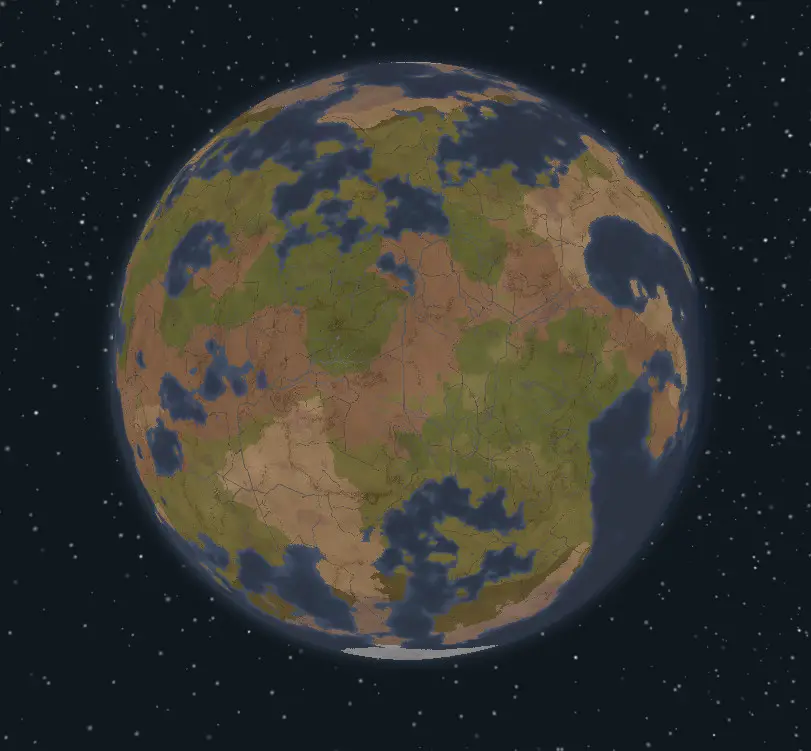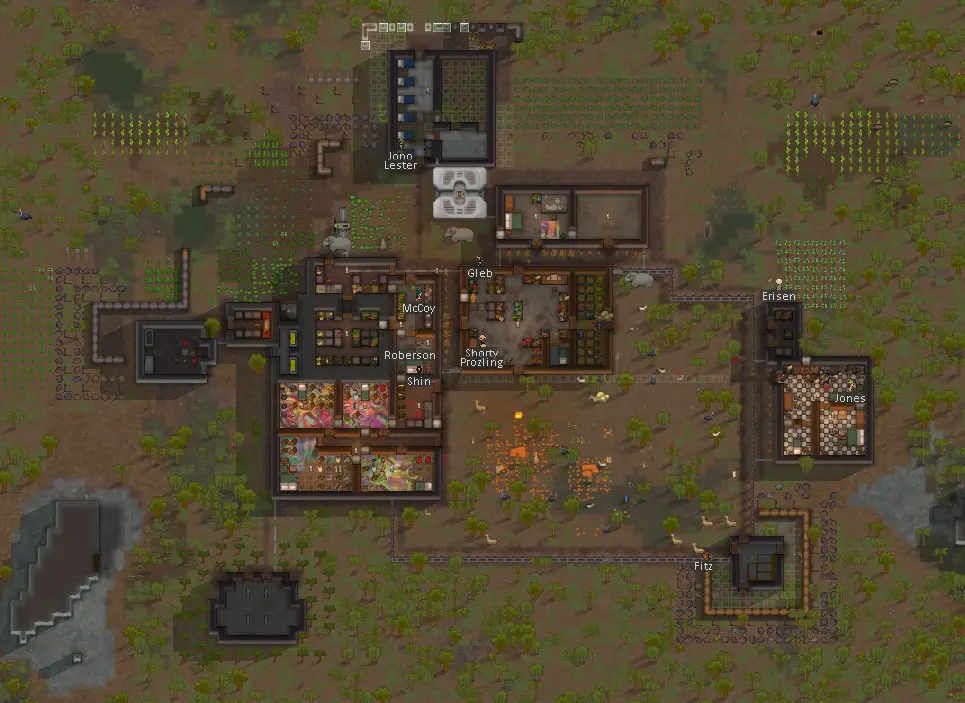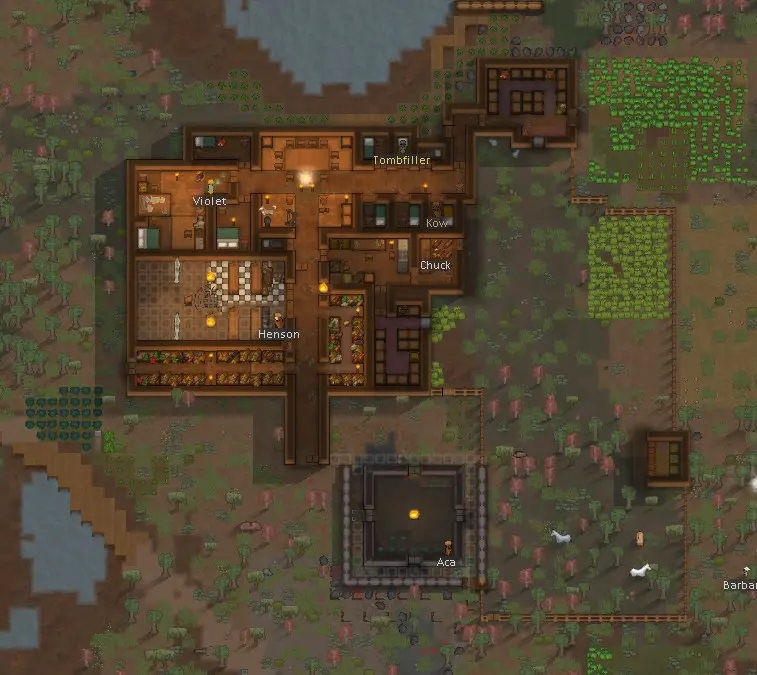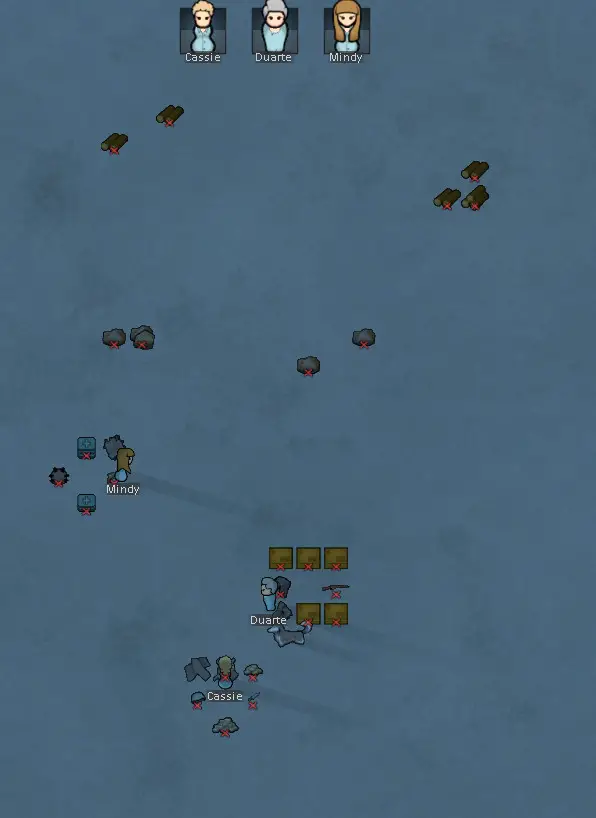Ranking Rimworld Biomes For Difficulty
Here we will discover the definitive difficulty ranking of Rimworld’s twelve biomes. We will also consider how terrain features like hills, rivers and roads can shift the difficulty for certain biomes.
Find Rimworld merch on Amazon here.

Starting with the easiest we have…
Tropical Rainforest
Some might rate the temperate forest biome as easier than the tropical rainforest but from my experience the reverse is true. Tropical rainforest has the huge advantage of a year round growing season and abundant wildlife.

In addition to a year round growing season there is an abundance of fertile soil. You have to work really hard to starve in this biome.
Heat
The tropical rainforest is hot but on the other hand does not get cold snaps. The extreme weather you have to face is just the same weather you already have to deal with but just a bit more. Temperate climates on the other hand can throw both heat waves and cold snaps at you.
Heat waves will not kill your crops, only slow their growth, but cold snaps will kill exposed crops.
Abundance
The abundance of trees is fantastic for fuel and building materials. The flip side is that forest fires can become massive. However the heavy rainfall helps to mitigate that.
Food spoils fast, due to the heat, but on the other hand you never really need to store food for long because of the absence of winter.
The density of flora does slow caravans a bit but on the other hand caravans need carry less food because of the abundant forage. The excess of flora does also provide cover for attackers and for melee fighters.
Animals
The rainforest has its fair share of predators but the lack of winter food shortages and abundant game means they are rarely motivated to hunt colonists or their animals.
The tropical biomes are also frequented by elephants, one of the most useful animals in the game.
Cons
The main pain point of the tropical biomes is that infectious disease is more common, while healroot does not grow in the wild.
The livability of the tropical biome depends strongly on a decent enough plants skill to cultivate healroot (plants 8). A good doctor (or two) is important too.
Staple crop: rice, corn, but anything will grow well.
Choice domestic animals: alpaca, elephants
Choice game: caparya
Chief predator: cobra, panther
Key survival technologies: air conditioning, medicine production
Tropical Swamp
The tropical swamp has many of the advantages and disadvantages of tropical rainforest: abundant trees, fertile soil, year round growing season and plenty of wildlife but more disease and no wild healroot.
The trick is that much less ground is able to bear buildings. You must plan your base layouts more carefully. However the wet ground helps to slow attackers and creates defensible bottlenecks similar to hills. Except where hills block line of sight, the patches of water enable shooting over.
The terrain slows caravans even more than tropical forest. However tropical swamps tend to be much smaller that tropical forest.
The extreme fertility and year round growing makes for fantastic agricultural productivity.
Staple crop: rice, corn and strawberries, but anything will grow well.
Choice domestic animals: alpaca, elephants
Choice game: caparya
Chief predator: cobra, panther
Key survival technologies: air conditioning, medicine production
Temperate Forest
The temperate forest biome has quite a lot of advantages. Plentiful trees and a long growing season.
The weather can be unpredictable though, as you can get hit both by heatwaves and cold snaps. The existence of winter means you will have to plan for seasonal food shortages and the unpredictable weather can spoil a harvest.
Disease is less common than in the tropicals and healroot grows wild so there is less need for a pawn with great plants skill to start.
Staple crop: rice and potatoes
Temperate Swamp
Rather like the relationship between tropical forest and tropical swamp, the temperate swamp is like the temperate forest but with less build-able ground but also higher fertility.
The higher fertility helps with agricultural yields but you will still face a winter and unpredictable weather so faster growing crops are to be preferred.
Staple crop: strawberries and rice
Cold Bog

Much like the temperate swamp, the cold bog enjoys fantastic fertility however the lower temperatures mean a much shorter growing season. There is plenty of wood for fuel and building materials. For this reason it is probably the easiest of the cold biomes for tribals.
Cold bogs are one of the rarer biomes and still more rarely feature hills. Hills do not really make this biome any easier. They will make moving about the biome even slower and will reduce fertility by reducing growing areas.
The defensive value of hills is moot when you can use the water in a similar way.
Staple crop: rice
Key survival technologies: pemmican / survival meal, complex clothing (parkas), electricity (sunlamps)
Boreal Forest
The boreal forest has long brutal winters but plenty of trees and decent amount of game for hunting. The fertility is respectable but the growing season is very short.
Staple crop: potatoes
Choice domestic animals: muffalo, yak
Choice game: turkey, elk, boar, hare
Chief predator: timber wolf, arctic wolf
Key survival technologies: pemmican / survival meal, complex clothing (parkas), electricity (sunlamps)
Arid Shrubland
Arid Shrubland enjoys year a year round growing season but patchy fertility. There is a relative scarcity of wood but fibrecorn can be cultivated just fine. There is a lack of wild game.
Staple crop: corn
Choice domestic animals: horse, dromedary, elephant
Choice game: none really
Chief predator:
Key survival technologies: tree sowing, air conditioning, hydroponics
Desert (Cold and Hot)

Deserts have very low rainfall and consequently very low fertility. Deserts do not necessarily have a year round growing season to compensate either.
Cold deserts will have the double trouble of the short growing seasons of winter climates along with the low fertility of low rainfall.
The small benefit of a desert environment is a low risk of disease.
Hills greatly increase the viability of the desert. Hills provide a source of shade and building materials.
Staple crop: potatoes (cold desert), corn (hot desert)
Choice domestic animals: dromedary
Choice game: iguana
Chief predator:
Key survival technologies: air conditioning, hydroponics
Tundra
Tundra share the perils of the other colder climates like boreal and cold bog: a short growing season and risk of hypothermia, but with none of the advantages. Fertility is less and worse still trees are almost non-existent.
The absence of wood for building and fuel is particularly difficult in cold environments, especially for a tribal start. Electricity gives alternative sources of light, heat and cooking energy besides that of wood.
The tribal economy is very dependent on wood. Consequently tundra is quite significantly more challenging for tribals compared with boreal or cold bog. See my survival guide to the tundra for tribals for more particulars on that.
Hills will make the tundra easier. Tunnels and caves can be used for making an indoors environment without wood, even by tribals.
Staple crop: potatoes, nutrifungus
Choice domestic animal: muffalo, yak
Choice game: elk
Chief predator: arctic wolf
Key survival technologies: pemmican / survival meal, complex clothing (parkas), electricity (sunlamps)
Extreme Desert

The extreme desert is, as you might expect, like the desert but even worse. Even with a year round growing season, fertility is so low in the extreme desert that only potatoes will grow marginally well outside. Digging out caves for growing fungus has some potential for those with the Tunneller meme.
Hydroponics turns that all on its head though. Unlike with the colder biomes you can have your hydroponics outside, so no need for sun lamps.
A complete absence of trees, also makes for a severe poverty in fuel and building materials for tribal starts. More technological starts have the advantage of windpower for energy and stone for building.
Hills are even more valuable in the extreme desert.
Staple crop: potatoes, fungus
Choice domestic animals: dromedary
Choice game: iguana
Key survival technologies: air conditioning, hydroponics
Ice Sheet
Nothing grows, no trees, no forage and no crops. Short of hydroponics, a geyser warmed fungus farm might work for food, if you can build that before freezing and starving to death.
Wildlife is rare and either too small to nourish, like snow hares, or too dangerous to tackle, like polar bears.
That is not to say it is impossible to survive there but you need a lot of starting resources to make it work.
Geysers are even more valuable here than in the tundra.
The one advantage is that the environment itself makes for a deadly trap for any raiders, and will even freeze dry their corpses for you to eat later. It also makes keeping toxic waste packs frozen much easier. Consequently toxifier generators and mechaniator pawns are even more useful.
Hills make this biome much easier. Stone, tunnels and caves are a fine substitute to wood for building. You will be lucky indeed to get a geyser near a hill. The larger the hills the luckier you will be.
Mining and construction skills are key.
Staple crop: geyser warmed fungus farm or rice in hydroponics
Choice domestic animals: muffalo
Key survival technologies: complex clothing (parkas), electricity (sunlamps, heaters), hydroponics, toxifier generator
Sea Ice
No, just no. If ice sheet is all but impossible, sea ice is both actually impossible and utterly pointless. There is absolutely nothing there, just sub-zero temperatures.
You could hypothetically migrate there with sufficient resources built up somewhere better. The only reason to do so is if this is where the crash landed ship spawns.
No geysers, so no geothermal power or passive heat. No building materials beyond whatever fell out of the sky with you. Nothing to hunt. There is just the great white killer nothingness of endless snowy waste.
Staple crop: none
Key survival technologies: complex clothing (parkas), electricity (sunlamps, heaters), hydroponics, toxifier generator, micro-electronics (orbital trade beacon, comms console)

There we are, all twelve Rimworld biomes ranked for difficulty, including tips and thoughts on the influence of terrain. Which is the hardest biome you dared to try? How did you get on?
Share this article to my twitter @SolarCrossGames or my reddit community r/SolarCrossGames and let’s chat about it.
Discover more of my Rimworld stories and articles by clicking here – Solar Cross’s Rimworld articles.